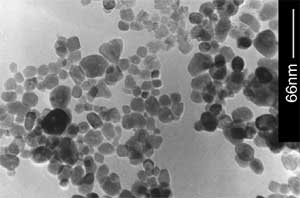| Posted: January 8, 2007 |
Nanotechnology glass ceramics for photonics |
|
(Nanowerk News) The goal of a new EU-funded research project is to clarify mechanisms which enable the formation of large quantities of crystals with diameters in the nanometer range with small crystallite size distribution.
|
|
Interface Controlled Nucleation and Crystallisation for Nanoparticle Synthesis (INTERCONY) is a materials science project bringing together theoretical studies, computer simulations and experimental studies on the formation of interfaces during nucleation and crystal growth in liquids.
|
 |
| Indium tin oxide nano particles prepared by crystallisation from a borate glass and subsequent dissolution of the glassy matrix (Image: University of Jena)
|
|
The consortium is a strongly interdisciplinary team consisting of groups, involved in materials science research (glass), physics (computer simulation, transmission electron microscopy), physical chemistry (theory of nucleation and crystallisation) as well as Europe´s leading supplier of special glasses, engaged in glass research, development and production.
|
|
If a crystal is formed in a multicomponent liquid, it does not possess the same chemical composition as the liquid. Hence, in highly viscous liquids, the composition of the liquid will change near the emerging crystals. Such interface can form a diffusional barrier which leads to a decay in crystal growth velocity. Since in the latter case crystal growth is notably hampered, the formation of a high volume concentration of nano crystals with narrow size distribution is facilitated. INTERCONY will go beyond a purely thermodynamic and kinetic theory for nucleation and crystal growth by including a completely new approach taking into account the structure of the liquid. This is done by combining percolation theory with the theories of nucleation and crystal growth. Derived from fundamental studies, INTERCONY will furthermore provide guidelines for the preparation of nano glass-ceramics with emphasis on multifunctional materials especially for novel photonic applications.
|
|
The objectives of the project are:
|
|
– Enhancing the scientific understanding of preparation and properties of multifunctional materials.
|
|
– Drastic extension of knowledge on interfaces in multifunctional materials formed during nucleation and crystal growth.
|
|
– Development of strategies for the synthesis of amorphous matrix materials with a large volume concentration of nano crystals.
|

